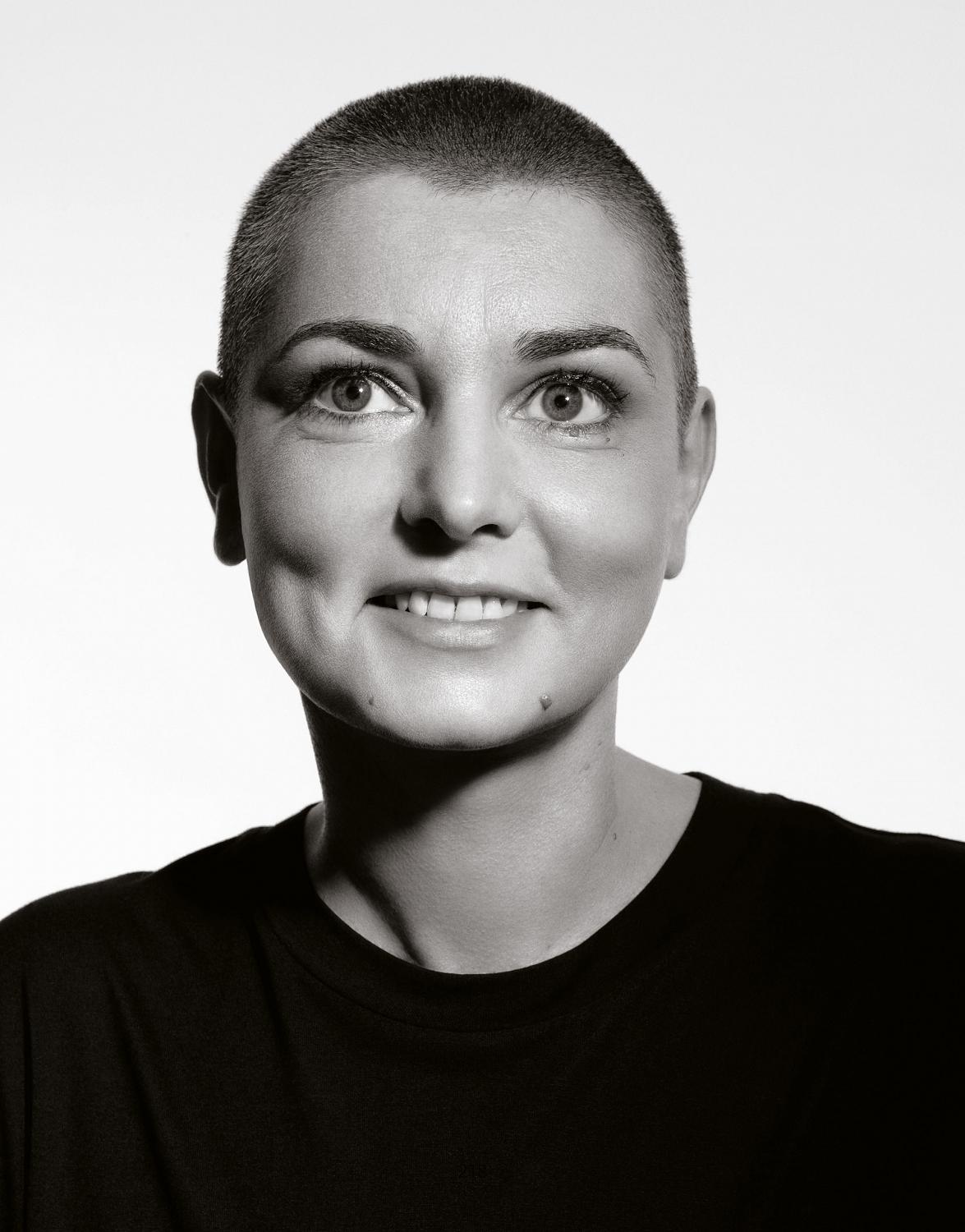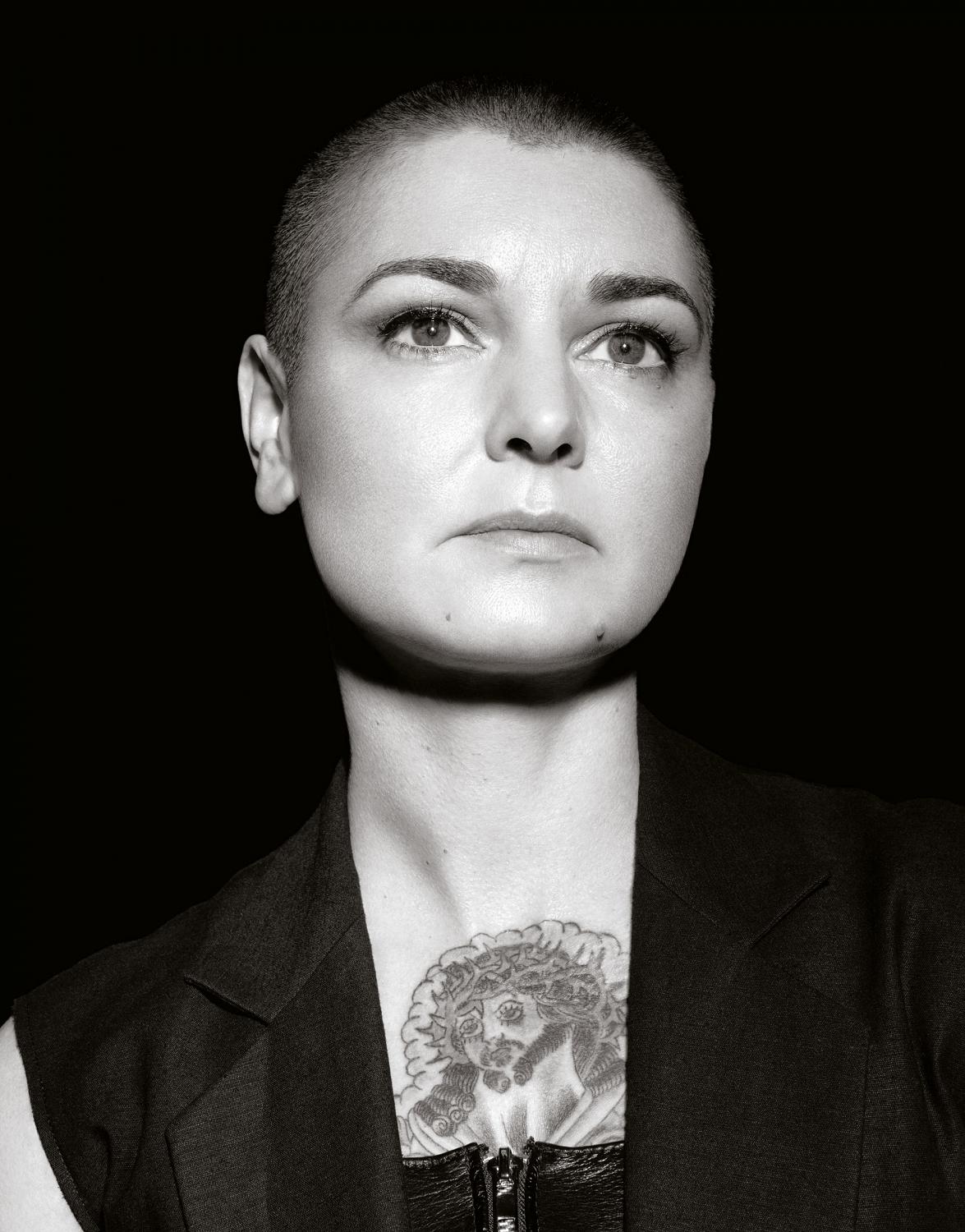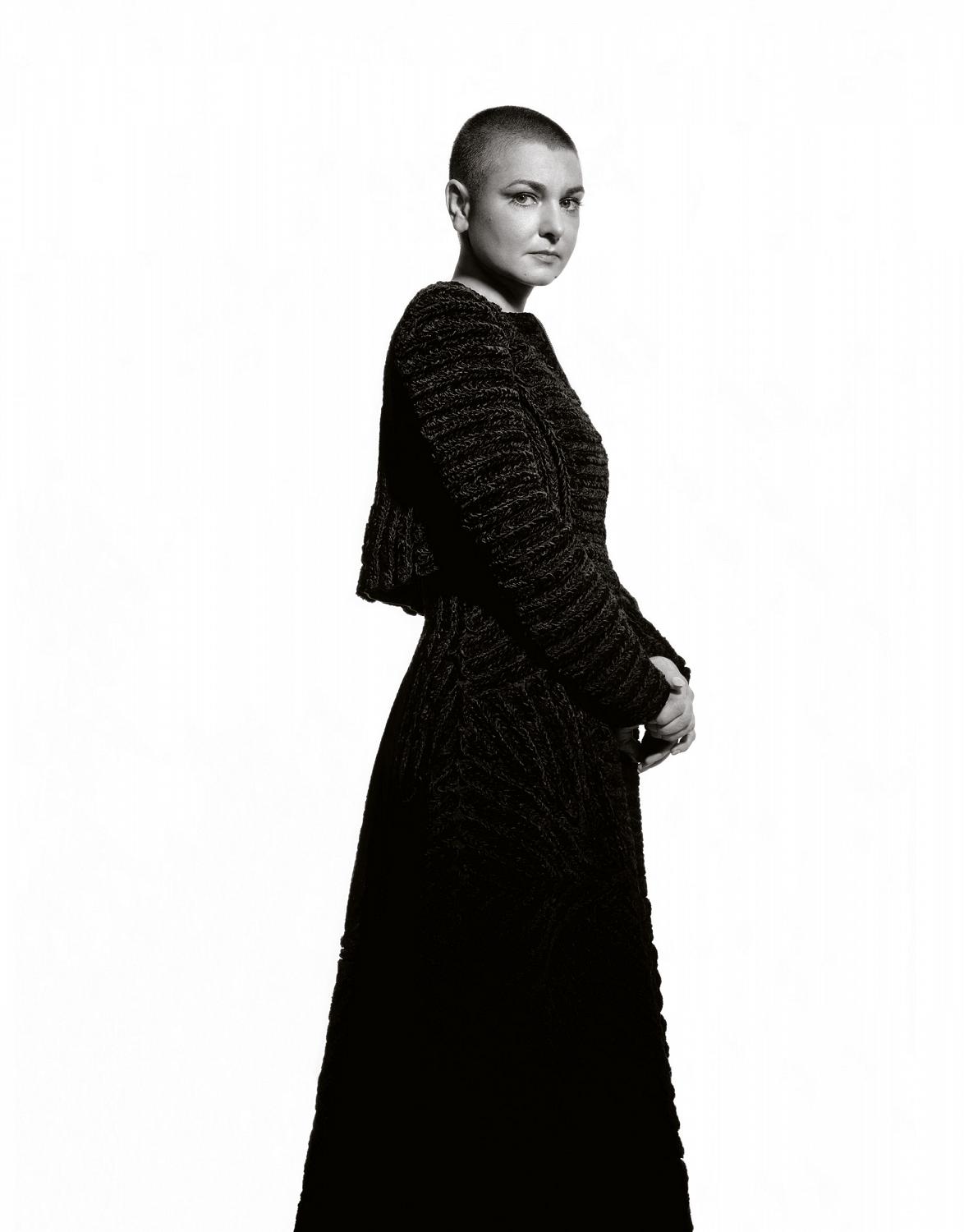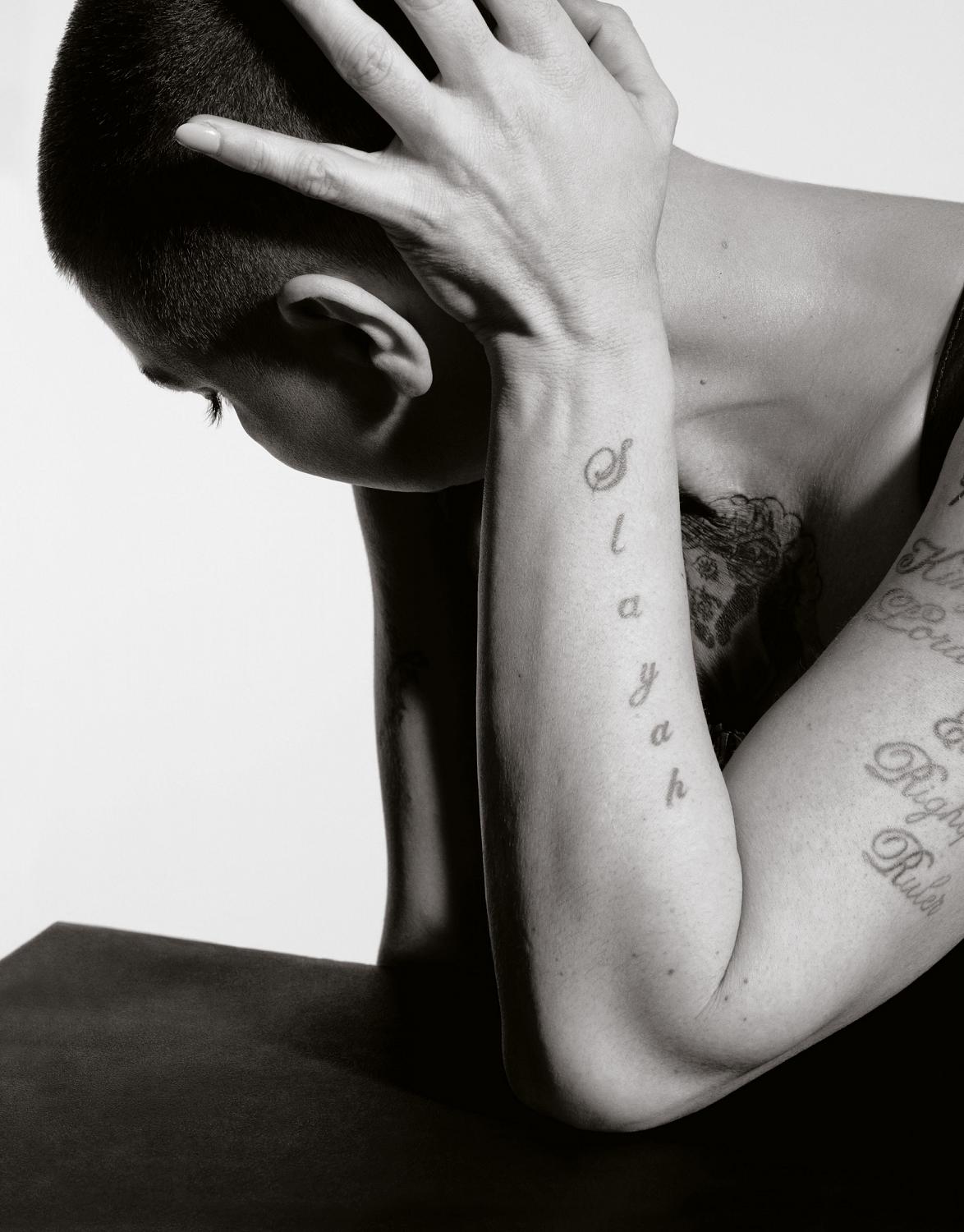Sinéad
O’Connor
The fabulously outspoken singer

Portraits by Andreas Larsson
Styling by Jonathan Kaye
Issue n° 5, Spring & Summer 2012
2012 looks to be a particularly promising year for Sinéad O’Connor. The Irish singer sprang into mass consciousness in 1990, weeping her way through a love song in extreme close-up when the rest of the pop world was still vogueing and raving. At times, since then, it’s been her colourful life and opinions rather than her crystal voice that have captured headlines.
Now, aged 45, she’s reclaiming her standing as a musician, with a new album out in February and a reinvigorated acceptance in the industry. Her personal life will never be uncomplicated, but now that she’s accepting that crazy is probably what she does best, she says, it’s making her rather happy.
“Dearest hacks,” reads the handwritten sign taped up in the porch of Sinéad O’Connor’s house overlooking the sea in Bray, just outside Dublin. “Here’s your quote: It’s rock ’n’ roll!” The day before my visit, Sinéad will tell me later, there was a mob of about 100 journalists on the front drive of her big Georgian house, all jostling to get the inside story on her brief marriage to Barry Herridge, a man she met after announcing on her website that she was looking for love. On 8 December last year – Sinéad’s 45th birthday – they were married in Las Vegas, in an event that, she wrote in her blog, was “too glorious for words.” But by 26 December, she’d put another notice on her website confirming they’d separated after just a week of living together and pleading for his privacy to be respected. Today, there’s a fierce storm blowing in from the sea, but the media’s absence has less to do with the wind and rain than with Sinéad’s decision to give four short interviews to key Irish publications, saying all she wants to say about a split she insists was totally amicable. And I’m ringing her bell, wondering how welcome yet another journalist is going to be.
We’ve met a few times over the years, Sinéad and I, and we’ve always got on well. But there’s no denying that she can be fragile emotionally. When we arranged this meeting, she’d just got married, and I’d been looking forward to an upbeat, happy chat about her new album and new love. Now, I’m dreading becoming a voyeur to her misery. But it turns out I’ve been worrying needlessly. Sinéad opens the door with a smile and a hug and turns out to be on top form, full of that impish tendency towards mischief that has been so misunderstood over the years.
“I just woke up one day feeling very happy, and decided I’d spent enough time being unhappy,” she explains. “There are so many things I didn’t do when I was young – partly because I was Irish and therefore repressed, and partly because I was sad, for good reason. Now I figure, fuck it, I’m 45 years of age, and I’m going to do everything I should have done when I was younger. Including being very silly and just having a laugh. The best way I can describe it is, parts of me that were dormant began to come alive. And the parts that weren’t terribly happy decided it was time to go to sleep. They’d had enough. So that’s why I’m not too down about break-ups or this, that and the other – because life is short, and everything’s good.”
Today, the house is empty except for Sinéad and her cute little Yorkshire terriers, Susan and Katie. “They’re filthy, I’m afraid,” she says. “They haven’t had a bath for days. I love them, though. They’re so funny. All they care about is food, sleep and snuggles. They’re like new babies.” Inside, the house is warm and homely, full of the cheerful clutter and chaos of family life. Spend any time at all with Sinéad and it’s clear that her children are the most important things in her life. Her relationships with their fathers have sometimes been complicated, but somehow, she’s made it all work. “It’s easy if you both want to.” She shrugs. “And it’s selfish not to. I’m a compartmentaliser.”
Her oldest son, Jake, is a good-looking lad of 24 with his own flat in London, where he works as a chef in a top restaurant. Her 15-year-old daughter, Róisín, has just acquired a huge husky puppy; the household also has a fat cat; and one of Sinéad’s two male nannies is about to get a dog. Toys belonging to her two youngest sons, Shane, 7, and Yeshua, 5, are everywhere, along with family photos, icons of the Virgin Mary, battered but comfy-looking sofas, luggage, musical gear, books and a pile of duvets waiting to go to the cleaners. The house is big – grand, even – but it’s also messy, comfortable and lived-in, rather than a sterile show home.

Describing the three hours it took to get the Jesus tattoo on her breastbone as “unremitting agony from start to finish,” Sinéad chooses her outfits to give her tattoo maximum exposure. Here, she wears a black wool sleeveless coatdress by Y-3 over her own leather corset. In the opening image, she wears a black silk T-shirt by MAISON MARTIN MARGIELA.
Dressed in red leather trousers and a green sweat top embellished with the Christian fish logo, Sinéad herself is similarly unaffected. Her face is free of make-up, and her dark, cropped hair is sprinkled with the first signs of grey. She looks great, but as we settle down to talk, she says she can only get away with being this casual because Róisín isn’t here. “She nags me to dress nicely – she puts make-up on me and makes me stagger around the shopping centre in my stilettos!”
She’s enjoying sharing this girly phase with her daughter – it’s something she says she missed in her own troubled childhood. By the time she was Róisín’s age, she was living with her father, who was one of the first men in Ireland to win full custody of his children. Her mother died in a car accident two years later, when Sinéad was just 17. “When I was growing up, she wasn’t well, so it was hard for her to make me feel good about being a girl. But now I find my daughter is doing that, which is fantastic and completely accidental.”
A few weeks before, she’d taken Róisín to New York for the US premiere of Albert Nobbs, a film starring Glenn Close as a woman passing as a man in order to work as a butler in 19th-century Ireland. Sinéad performs the lovely theme song, ‘Lay Down Your Head’, with lyrics by Close. Mother and daughter were dressed by Armani for the occasion – although Róisín, to Sinéad’s relief, opted not to do the red carpet. “I really didn’t want her to, but I didn’t want to force her not to, either. So I was glad she came to the conclusion herself. But she loved the glamour of it all: the dressing up, the travelling, the hotels and room service.” The song had just been nominated for a Golden Globe Award when we met and was being considered for an Oscar nomination. The following week, Sinéad was due to fly to Los Angeles to perform it at a party attended by the kind of A-listers who vote for the Oscars. “There will be all these producers like Quincy Jones, so I’m really looking forward to it.” She grins. “Maybe next time he’s looking for a backing vocalist, he might think, ‘I’ll call that crazy Irish bitch in!’ And also, the song is just glorious. I’ve done some weird, tiring, jet-lagging journeys just to sing that song once.” Suddenly, it seems Sinéad is embracing the kind of celebrity life she’s always shunned in the past. “I feel more comfortable in my own skin,” she agrees. “And I feel that I’m more accepted now, in that kind of showbiz world, for being me. When I first came along, I was a bit confusing – this bold, big-mouthed Irishwoman. But over the years, I think the industry has grown to know me a bit better, understand me and respect me as an artist.”
Sinéad has always followed her own path, even if at times it has been a lonely one. She was young and unprepared for the fame that engulfed her after the worldwide success of ‘Nothing Compares 2 U’ in 1990, and she famously sabotaged it by tearing up a picture of the Pope live on US TV in 1992 in protest at the abuse of children by priests, and by talking openly and honestly about her childhood, her faith and her sexuality. She caused uproar in Ireland in 1999, when she was ordained as a priest by a bishop from a breakaway Catholic church. Though the ordination of women is still not recognised by the Vatican, as Mother Bernadette Mary, Sinéad has maintained her authority to say Mass, perform baptisms and administer last rites.

Sinéad is wearing her own dress, made for her by GIORGIO ARMANI.
Since then, it’s become the norm to portray her as eccentric, self-destructive, even mad, but even if her message hasn’t always been articulated clearly, it has stayed consistent, and time has proved her right on many things. Report after report is now making clear the extent of both the abuse of children in Ireland and the Catholic Church’s attempts to cover it up. When I ask if she feels vindicated by this, she quietly says that isn’t important. “What matters is that the people this happened to have been vindicated.”
She’s learned to cultivate a better relationship with the press in recent years – “They’re very fond of me because I’m good copy, I’m colourful”– but also perhaps to use her internal edit button more often, to protect herself a little better. Although her faith is as strong as ever, for instance, she tends to see it now more as a personal matter than something to be discussed at length in the media. But ‘compromise’ is still not a word that features often in her vocabulary, and she’s now reached an age where people have come to respect her for simply remaining completely, unashamedly herself.
“Whether you like me or not is beside the point,” she says, “but I’m not fake. That’s one thing I can’t be accused of. And for singers, that’s very important. I teach singing to teenagers, and I always say that’s the first lesson to learn. The singers we love are the people who, when they open their mouth, from the first syllable you know who they are, because they’re 100 per cent themselves.”
“The singers we love are the people who, from the first syllable you know who they are, because they’re 100 per cent themselves.”
It’s easy to forget now how radical she seemed in 1987, with her shaven head and angry, punky debut album The Lion and the Cobra. Since then, she’s taken long breaks to look after her children and moved through a wide range of musical styles, all of which had a logic to her but which probably stopped her building the kind of following she deserves. She’s recorded everything from jazz standards (on her third album Am I Not Your Girl? in 1992) to reggae tunes (on 2005’s Throw Down Your Arms), devotional music (Theology, in 2007) to contemporary reworkings of Irish traditional songs (2002’s Sean-Nos Nua), as well as albums of her own compositions. What’s united them all is that pure, clear, emotional voice – and an unwillingness to surrender her vision for anyone.
But her new album, How About I Be Me (And You Be You)?, is her most straightforwardly commercial for years. Released this February, it was recorded in London with her ex-husband and long-time collaborator, producer John Reynolds, who is Jake’s father as well as one of her best friends. “He knows me artistically better than anyone, so he knows how to get the best out of me. And he always has a very casual set-up in his house, so you don’t really feel like the red light is on. I was recording in my nightdress and slippers!”
There’s a well-chosen cover version on the album, a glorious interpretation of John Grant’s furious break-up song ‘Queen of Denmark’. There are narrative songs about characters such as a junkie and a single mum, and a handful of what she describes as “romantic, girly love songs.” These include ‘Old Lady’, a song about waiting till she’s older to consummate her crush on the film director Neil Jordan – who also happens to be best friends with Yeshua’s dad, American entrepreneur and bioengineer Frank Bonadio.
“I’ve known Neil since I was 19 or 20, and I always had a crush on him, before he was married, or before I met Frank. And they all knew it. I’m never going to act on it – it’s just a funny song about how one might fantasise occasionally about one’s boyfriend’s best friend! And I love the idea of being this old lady but still being this loving, sexual creature. Being 80, and sensually all wrapped up in the man I love.”
She’s full of plans. Last summer, she recorded a reggae track, ‘How About I Be Me?’, with producer Kemar ‘Flava’ McGregor. “I love Jamaica,” she says. “It’s so cool. We made the record, and it was out two days later!” Her frank, sweet plea for daily lovemaking made the song a huge hit there, and she’s off to the Caribbean in February for yet another awards ceremony. She says she wants to do more tracks with McGregor this year and would also like to do an album in which she sings opera arias in her normal voice, with contemporary musical backing, “because some of them are gorgeous songs, but they’re elitist.”
In the past year, her blog has turned into another important outlet for her creativity. “If I wasn’t a singer, I would have been a journalist. I’m just addicted to writing. So I love doing the blog and Twitter. And I have a stupid little section on my website which I love, which is letters to Bob Dylan.
We talk, for a while, about her battles with depression. Seven years ago, after her son Shane was born, she was feeling very low, even suicidal. Shane’s father, the traditional Irish musician Dónal Lunny, was married at the time, and things were difficult. “I felt it was my fault. I was really depressed.”
She went to her doctor for help and was diagnosed with bipolar disorder. The drugs she was prescribed made her feel much better at first. She started making music again, found a way to make Lunny a part of his son’s life, and talked in glowing terms on shows like Oprah about the difference the diagnosis had made. But slowly, over the years, she says, the dark thoughts crept back. After several re-examinations, she concluded last year that the diagnosis had been wrong and gradually, with difficulty, weaned herself off the meds.

Sinéad, who lives in the pretty tourist town of Bray on the east coast of Ireland, is wearing her own black leather corset.
At the same time, after years of therapy, she found a counsellor who specialised in childhood abuse and trauma, and this, above all, is what she credits with transforming her life. “He just knew how to work with me, and what my problems were, even if I didn’t know. From the second I walked into that man’s office, my life began to change for the better, and I began to come alive. I just got very lucky – and sadly, it is about luck, and money. I can afford £100 a week to go see this therapist. It’s tragic and wrong that people don’t get to go because they don’t have money.”
Sinéad says she believes happiness is a person’s natural birthright. Happiness is a choice. You can get up every day and you can choose to be miserable, or you can choose to be happy. When people said that to me when I was younger, I used to think, ‘What do you know? I’ve got plenty to be unhappy about.’ But now, I feel differently.”
Part of her recovery, Sinéad says, involved revitalising her love life, which had lain fairly dormant after she separated from Yeshua’s dad. So she announced on her blog that she was looking for love, expressing sympathy with an American woman she’d read about, who was so desperate she’d resorted to humping her truck. Sinéad went onto several dating sites, then repeated her requirements on an Irish TV show. They were quite specific. Her dream man had to be single, Irish, employed, older, affectionate, hairy and stubbly – clean, but with no smell of aftershave. “I had about 1,000 answers, ranging from complete fucking lunatics, perverts and psychos to really sweet guys who just wanted to go for dinner.” She also had an email from a Chinese truck manufacturer sending her its vehicle specs. “They’d obviously misread the blog,” she says.Of course, much of this was reported in the press as yet another example of the continuing craziness of Sinéad O’Connor, but I have several friends in their 40s – gorgeous, smart, successful women – who for one reason or other have ended up as single mums wondering where all the good men have gone. Being brave enough to put yourself out there and ask – quite specifically – for what you want seems saner than staying lonely.
“And it’s been such fun!” Sinéad adds. “I think women are just as slutty as men are. I don’t think we’re all that different from men sexually; it’s only that we’ve been raised to be all quiet about it.” Last time she was in Los Angeles, she had an injection in her G-spot, designed to increase sexual response. “It’s great!” she enthuses. “And I’m happy to report that it lasts for a very long time.” She also took steps to ensure that there would be no more children. “I’ve had my tubes done, and that’s sort of set me free as well. Best thing I ever did, except I have a scar that won’t go away. But it was only a few months ago.”
Finally, I broach the subject of her brief marriage. “Look.” She shrugs. “I know this might seem dreadfully cold-hearted, but I actually do see the funny side of it all. There’s no point crying. I’ve had enough practice. I know what happens when you break up. You feel shit for an hour or two, then you’re all right, then you’re shit for another hour or two, and then one day, you’ll wake up and you’ll be grand. The best way to get over one man is to get under another!”
Things could be worse, she adds. “There’s no bad vibes, we haven’t had a bad word between us, we haven’t been mean to each other, there’s nothing but niceness. So I can’t complain.”
She’s kept the reasons for their split deliberately, uncharacteristically vague in order to protect her husband’s privacy, but it seems that he was unprepared for the publicity that followed their wedding and that people close to him heartily disapproved of the union. Given that he’s a drugs counsellor working with children, it also seems spectacularly insensitive of Sinéad to have insisted they spend their wedding night in a taxi searching for celebratory weed in the most dangerous parts of Las Vegas. Both cab driver and new husband were terrified, she cheerfully admitted in her interview with the Sun newspaper, especially when they were offered crack instead of the rather more benign drug she’d been seeking.
But still – she shrugs – it’s only rock ’n’ roll. “That’s become my general life motto,” she says, “in the last year or two, as part of discovering who I actually really am. I’m a rock-’n’-roll type of person, I’m not regular, or normal – whatever that is. So if shit happens, I just go, ‘Rock ’n’ roll.’ And anyway, who gives a shit? Millions of people are breaking up every day.”
Undeterred, she says she’s already back on the dating sites, looking for love – but not marriage this time. “I’ve accepted that I’m not wife or girlfriend material, but I’m great mistress material. And I don’t mean with married men – those days are gone. When I was young, I used to sleep with other people’s husbands. As my sister says, I’ve had many husbands – some of whom were my own.” She laughs and says that’s not what she wants now. “Ideally I’d love to be an adoring mistress to maybe three or four nice men who would be nice and kind and sweet – and filthy.”
If you think this sounds like a woman on the rebound, fronting out her pain, you’re probably right. Certainly it wasn’t a great surprise when, a week or so after we met, she texted to say that she and her husband had got back together again. Things will probably have shifted again by the time you read this, and no doubt it will all be diagnosed in the press as yet another sign of the continuing madness of Sinéad O’Connor. The difference is that the Sinéad of old, who would have taken it all to heart and placed adverts in the papers begging to be left alone to live a normal life, has matured, grown in confidence, and become able to see the funny side of it all. And able to understand that normality may be overrated.
“I just don’t take it personally now,” she told me in our interview. “If there is a bit of the old ‘crazy Sinéad’, I think there’s nothing wrong with being a bit crazy. In fact, Jesus Christ was the craziest fucking person that ever lived, if you think about it. I have a theory about musicians: we don’t live by the same rules as everyone else, and people almost expect that of us. We do your crazy for you.”
Sheryl GarrattA decade or so ago Sheryl Garratt was often awake at dawn, dancing in nightclubs and drinking vodka shots. She is still often up early, but these days you’ll find her foraging in the fields for mushrooms or for seaweed on the shores of Deal in Kent, where she now lives. The former editor of The Face…read more Portraits by
Andreas LarssonThe delightful Swedish photographer Andreas Larsson lives in London. His contributions to magazines such as Fantastic Man, BUTT, Candy, GQ Style and Pin-up are characterised by up-beat scenarios and exquisitely flattering studio lighting. Andreas has shot campaigns for COS, H&M, J.Lindeberg and Uniqlo…read more Styling by
Jonathan KayeJonathan Kaye is fashion director of The Gentlewoman. A graduate of Central St. Martins' prestigious MA Fashion course (the good ones often are), Jonathan is one of the most industrious stylists in the business and thus operates on a “strictly no parties” basis. He has collaborated with photographers…read more
Hair: Naoki Komiya at Julian Watson Agency. Make-up: Janeen Witherspoon at Julian Watson Agency using Guerlain. Manicure: Rebecca Jade Wilson. Photographic assistance: Nick Chard. Styling assistance: Max Ortega Govela. Digital operation: Johnny Dufont. Post-production: The Looking Glass. Production: Anna Zoumaras at Rosco Production.
This profile was originally published in The Gentlewoman n° 5, Spring & Summer 2012.